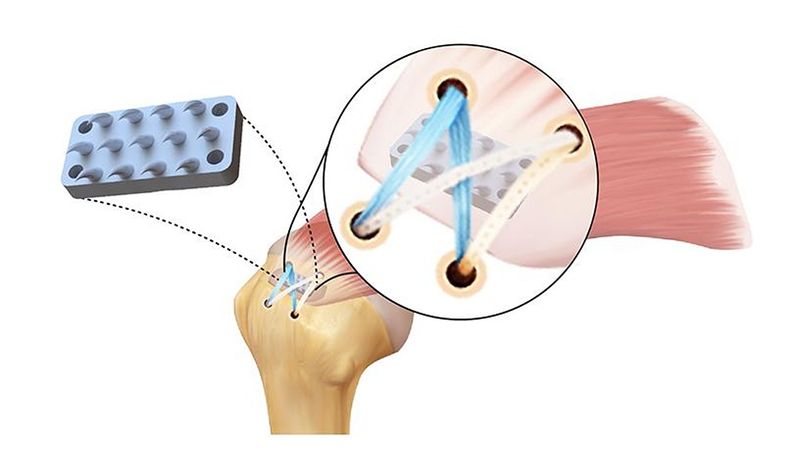New Device Inspired by Python Teeth Doubles Strength of Rotator Cuff Repairs
Columbia University team uses biomimicry to create a device that may reduce the risk of rotator cuff re-tearing in patients.

Schematic of the python tooth-inspired device interposed between tendon a bone significantly enhances standard rotator cuff repair. Credit: Iden Kurtaliaj/Columbia Engineering
This article was first published on
www.engineering.columbia.eduMost people, when they think about pythons, visualize the huge snake constricting and swallowing victims whole. But did you know that pythons initially hold onto their prey with their sharp, backward-curving teeth? Medical researchers have long been aware that these teeth are perfect for grasping soft tissue rather than cutting through it, but no one has yet been able to put this concept into surgical practice. Over the years, mimicking these teeth for use in surgery has been a frequent topic of discussion in the lab of Dr. Stavros Thomopoulos, a professor of orthopedics and biomedical engineering at Columbia University.
Biomimicry key to new study
A leading researcher focused on the development and regeneration of the tendon-to-bone attachment, Thomopoulos is particularly interested in advancing tendon-to-bone repair, necessary for rotator cuff repair and anterior cruciate ligament reconstruction. In a paper published today by Science Advances, his team reports that they have developed a python-tooth-inspired device as a supplement to current rotator cuff suture repair, and found that it nearly doubled repair strength.
“As we grow older, more than half of us will experience a rotator cuff tear leading to shoulder pain and decreased mobility,” said Thomopoulos, who has joint appointments at Columbia Engineering and Columbia’s Vagelos College of Physicians and Surgeons as the Robert E. Carroll and Jane Chace Carroll Professor of Biomechanics (in Orthopedic Surgery and Biomedical Engineering). “The best medical intervention is rotator cuff surgery, but a remarkably high percentage of these repairs will fail within just a couple of months. Our biomimetic approach following the design of python teeth helps to reattach tendons to bone more securely. The device not only augments the strength of the repair but can also be customized to the patient. We’re really excited about the potential of our device to improve the care of rotator cuff injuries.”
Rotator cuff injuries
Among the most prevalent tendon injuries, rotator cuff tears affect more than 17 million people in the United States each year. The incidence of injury increases with age: more than 40% of the population over 65 years old experience a rotator cuff tear.
Because rotator cuff tears typically occur at the tendon-to-bone insertion site, rotator cuff repair is aimed at anatomically restoring the tendon attachment. Surgical repair is the primary treatment for restoring shoulder function, with more than 600,000 procedures performed annually in the United States at a cost of $3 billion.
However, successfully reattaching tendon to bone remains a significant clinical challenge. High failure rates occur following surgery, with rates increasing with patient age and tear severity. These rates range from 20% in younger patients with minor tears to a staggering 94% in elderly patients with massive tears. The most common failure of rotator cuff repairs is sutures tearing through the tendon at the two or four grasping points where forces concentrate.
While there have been advancements in rotator cuff repair techniques over the past 20 years, the fundamental approach of sewing two tissues together has remained largely unchanged, still relying on sutures transferring tension at high-stress grasping points. Following tendon-to-bone reattachment surgery, sutures can tear through tendons at these points of high stress, a phenomenon known as “suture pull-through” or “cheesewiring,” leading to repair-site gapping or rupturing.
“We decided to see if we could develop a device that mimics the shape of python teeth, that would effectively grasp soft tissues without tearing, and help reduce the risk of tendon re-tearing after rotator cuff repair,” said Iden Kurtaliaj, the study’s lead author and a former biomedical engineering PhD student in the Thomopoulos’ lab.
The device
The team’s original idea was to copy the shape of python teeth, but they went much further, using simulations, 3D printing, and ex vivo experiments on cadavers to explore the relationship between tooth shape and grasping vs. cutting mechanics. Kurtaliaj manufactured a range of tooth designs, optimized individual teeth, arrays of teeth, and finally a rotator cuff-specific array of teeth. The end result was a biomimetic device, made of a biocompatible resin -- an array of teeth atop a curved base -- capable of grasping, not cutting, tendon. The teeth are relatively small -- 3mm high for a human rotator cuff, about half the length of a standard staple -- so that they won’t poke through the tendon. The base can be customized via 3D printing to match the patient-specific curvature of the humeral head at the supraspinatus tendon attachment site (the most commonly torn rotator cuff tendon).
“We designed it specifically so that surgeons won’t need to abandon their current approach--they can simply add the device and increase the strength of their repair,” Kurtaliaj noted.
The team
Kurtaliaj led the research as a PhD student under the mentorship of Drs. Stavros Thomopoulos and Guy Genin, the Harold and Kathleen Faught Professor of Mechanical Engineering at Washington University in St. Louis, with input for clinical implementation from Dr. William Levine, chair of the Department of Orthopedic Surgery at Columbia University's College of Physicians and Surgeons.
“Due to our laboratory's close collaboration with orthopedic surgeons, we were especially fortunate to get input from Dr. Levine, along with other surgeons at Columbia, throughout the device's design development process,” said Thomopoulos.
Next steps
The researchers are now working to develop a bioabsorbable version of the device that would degrade as the rotator cuff heals back to bone, further enhancing its clinical applicability. They are also preparing for a pre-submission meeting with the FDA to facilitate the transition of their device into the market.